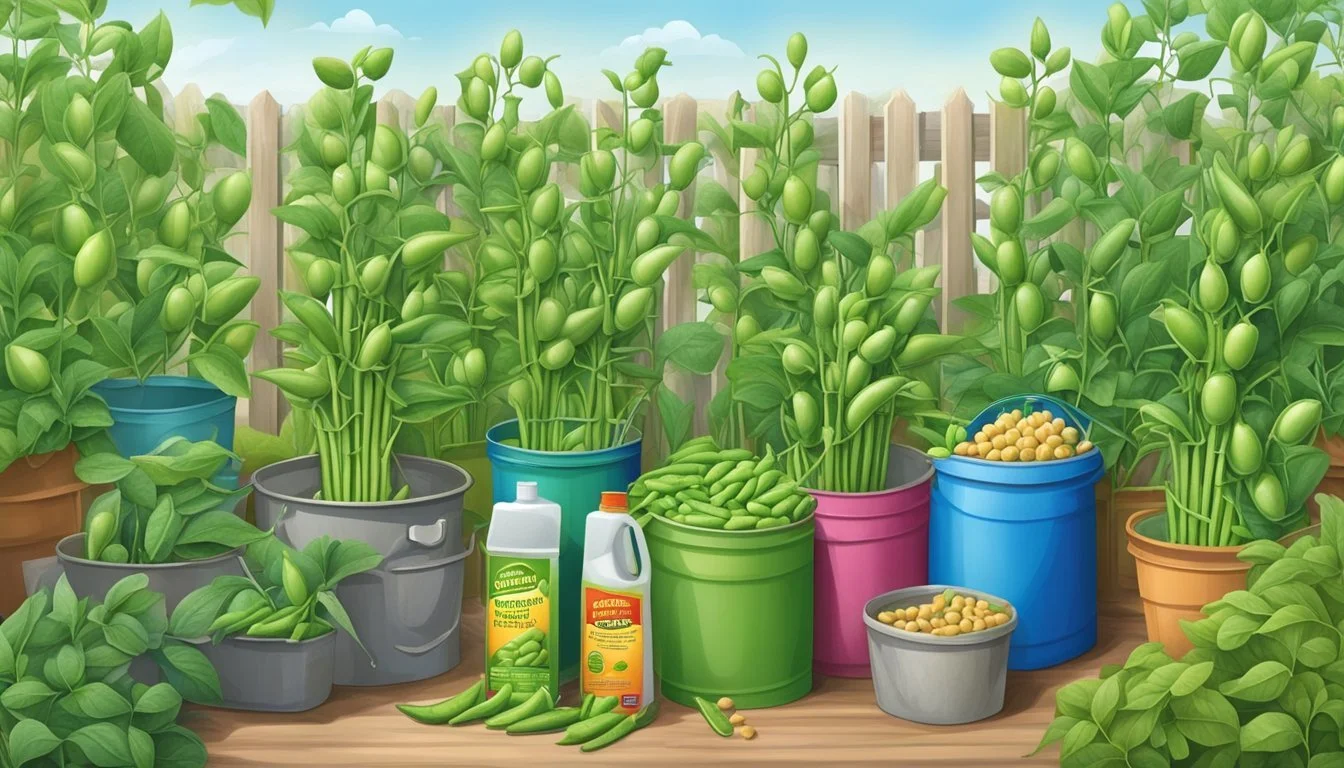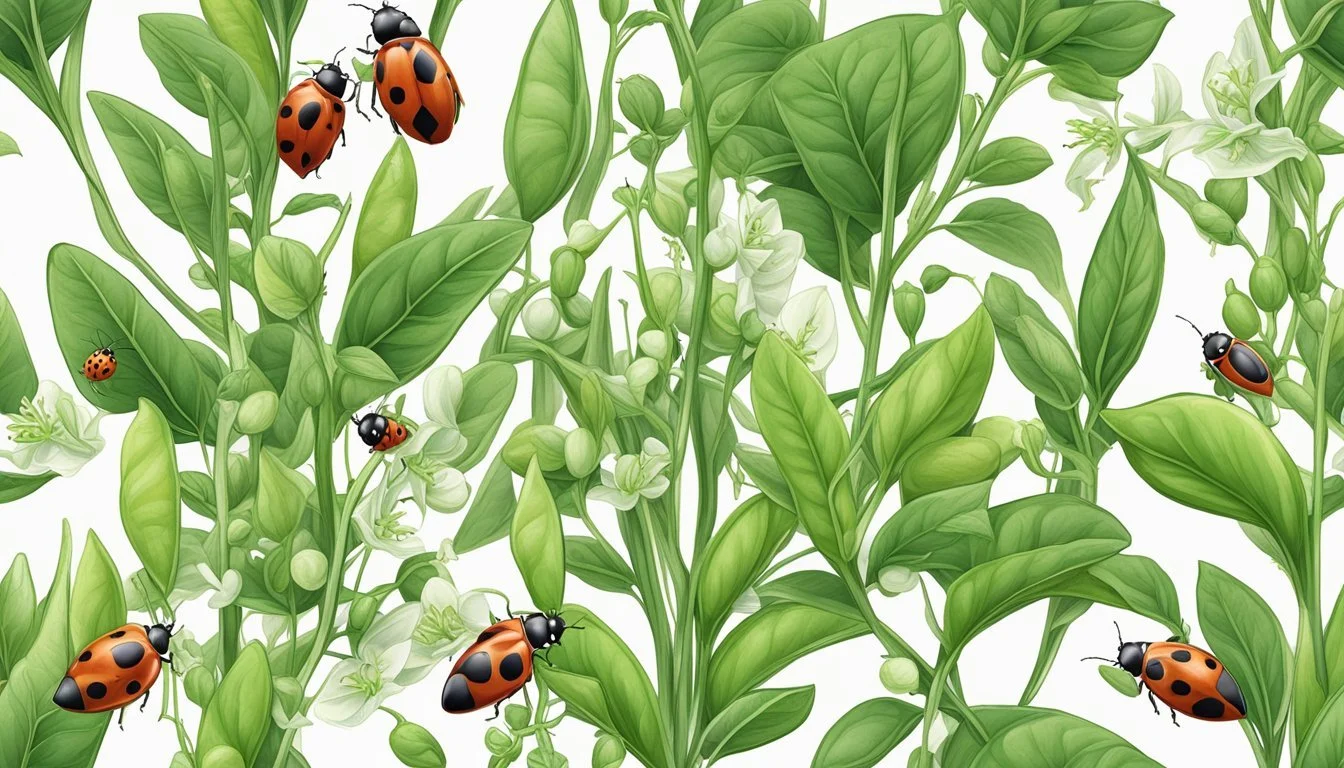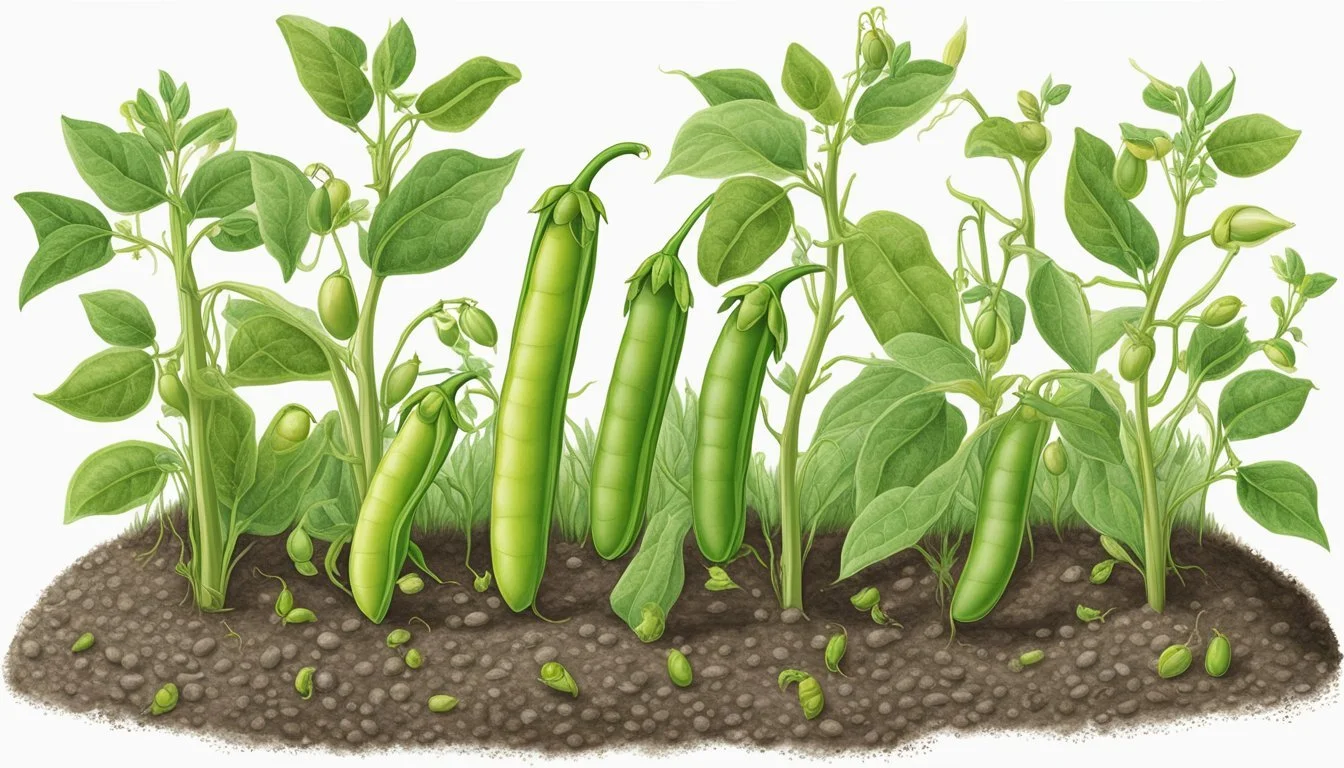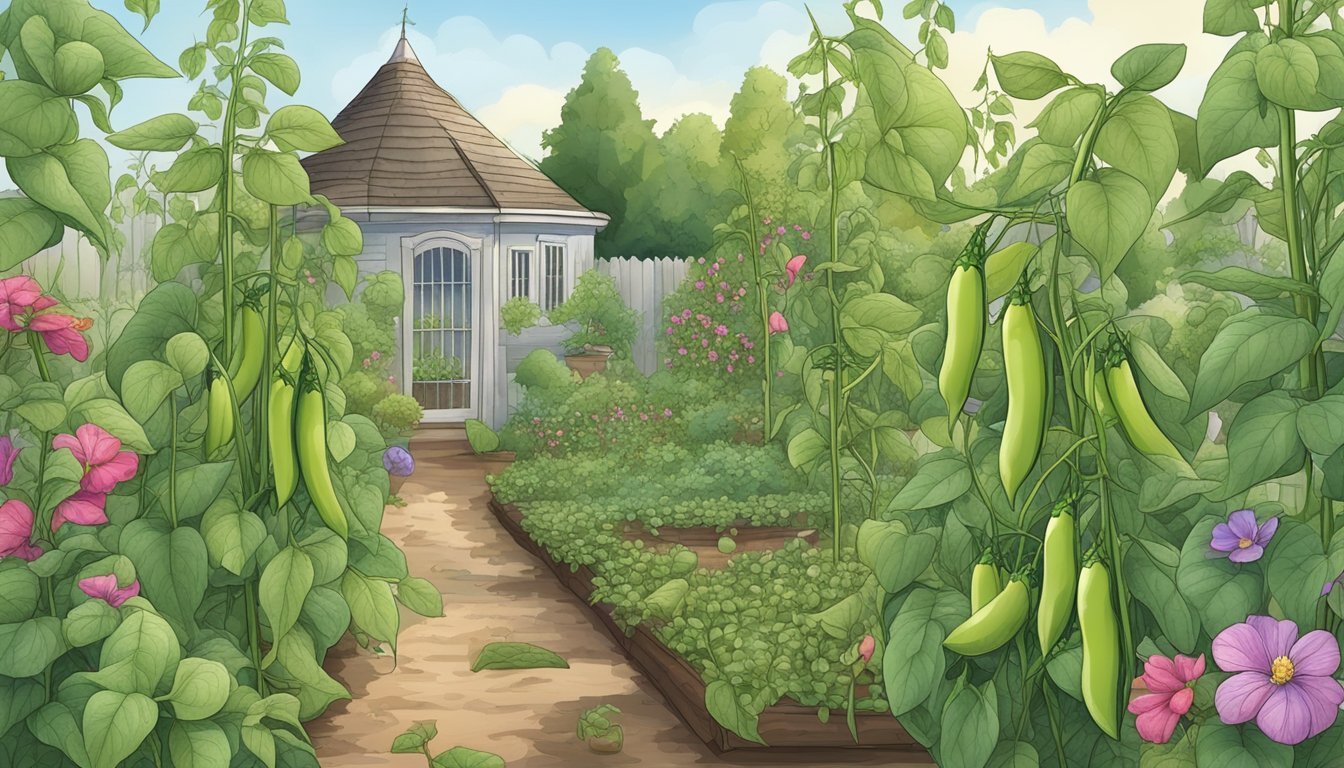Pest Control for Snap Peas
Effective Strategies for a Healthy Harvest
Snap peas are a garden favorite for their sweet flavor and crunchy texture, but like many crops, they are susceptible to pest infestations and diseases. Pest control for snap peas involves proactive monitoring, early detection of potential problems, and timely intervention to prevent damage. Addressing the pests that target these leguminous vegetables is crucial for maintaining healthy plants and ensuring a bountiful harvest.
Common pests that afflict snap peas include aphids, which damage the plant by feeding on the terminals, and the equally destructive pea weevil. Insects such as stink bugs present a serious threat during late summer and fall by damaging both the pods and the seeds within. Moreover, diseases like fusarium wilt can decimate a snap pea crop, and once infected, the plants should be removed to prevent the spread of the disease.
Effective management strategies range from employing natural predators and beneficial insects to utilizing organic or chemical pesticides. Gardeners must be vigilant and prepared to deploy a combination of preventive measures and control techniques to protect their snap pea crops from these prevalent concerns.
Understanding Snap Peas
Snap peas, or Pisum sativum var. macrocarpon, are a cool-season, annual crop enjoyed for their crunchy pods and sweet flavor. They thrive in full sun and display vigorous growth when provided with proper care and suitable conditions.
Snap Pea Varieties
There are several varieties of snap peas that are popular among gardeners and consumers. These include:
Sugar Snap: This variety is known for its sweetness and plump pods.
Super Sugar Snap: This type is resistant to powdery mildew and offers a high yield.
Cascadia: Highly regarded for its tender and flavorful pods, suitable for a range of culinary uses.
Each variety may differ slightly in sweetness, pod size, and resistance to specific pests or diseases.
Plant Growth and Lifecycle
Snap peas exhibit a distinct lifecycle that begins with seed germination. This process typically occurs within:
Temperature range: 40°F to 75°F (optimal germination at 60°F to 65°F)
Time frame: 7 to 14 days for sprouting
Once germinated, snap pea plants progress through a phase of vigorous growth. Key lifecycle events include:
Vegetative Stage: The development of leaves and vines.
Flowering and Pod Development: White or pink flowers bloom and then give way to pod formation.
Harvesting: Pods are typically ready to harvest within 60 to 70 days from planting.
For successful growth, snap peas require ample sunlight (ideally full sun) and well-drained soil, making them suitable for a wide range of temperate climates.
Preparing the Home Garden
A gardener’s success with growing peas in a home garden hinges on the initial steps taken to prepare the soil, plant the seeds properly, and ensure correct spacing and support for the growing plants.
Soil Preparation
The foundation for healthy snap peas begins with well-prepared soil. They require a sunny spot with well-draining soil. A gardener should work the soil to a depth of at least six inches and ensure a soil pH of 5.5 to 7.0. Before sowing the seeds, one can enhance the soil with organic matter to improve its fertility and structure.
Planting Seeds
Direct sowing of snap pea seeds yields the best results. The seeds should be planted at a depth of about 1 inch, ensuring that they have ample room to absorb water and expand. If pre-soaking seeds, it should be done in room-temperature water to hasten germination.
Spacing and Support
Proper spacing is critical for air circulation and maximizing yields. Snap peas should be planted 1 to 1½ inches apart, in rows 18 to 36 inches apart. They also require support such as a trellis or fence because they are climbing plants that need something to cling to as they grow. Positioning the support system at the time of planting helps prevent damage to the developing roots and shoots.
Pest Identification and Effects
Effective management of pests in snap peas requires accurate identification and understanding of the potential effects on plants. Insect pests can damage leaves and pods, while plant diseases can impact the overall health and yield of the crop.
Common Insect Pests
Aphids: These small, sap-sucking insects often appear in clusters on the undersides of leaves and on stems. They can cause distorted pods and stunted plant growth. It is documented that aphids can also transmit virus diseases to snap peas.
Beetles: Various beetle species, such as the bean beetle, feed on the foliage and sometimes the pods, leaving behind a tell-tale pattern of damage. For more specifics on beetles affecting beans and peas, refer to Pests of Beans and Peas.
Recognizing Plant Diseases
Powdery Mildew: A common fungal disease identifiable by white, powdery spots on leaves and stems. It can inhibit photosynthesis, weakening the plants.
Fungal Diseases: Snap peas can fall prey to a variety of fungal diseases. The fungi typically manifest as various forms of leaf discoloration, wilting, and rotting of both foliage and pods. For insight into diseases like Fusarium wilt and how to control them, growers should be vigilant in their inspection routines.
Cultural and Physical Control Methods
In managing pests for snap peas in home gardens, cultural and physical control methods are effective strategies that focus on prevention and minimal disruption to the environment. These practices contribute to creating a hostile environment for pests such as snails and slugs, which are common adversaries of garden peas.
Crop Rotation
Crop rotation is a fundamental practice that involves alternating garden pea crops with plants from different families. This disrupts the life cycles of pests and diseases that are specific to peas, leading to a natural decline in their populations. For example, following peas with a root crop or a leafy green can minimize the likelihood of soil-borne diseases and pest carryover.
Year 1: Plant garden peas in the spring.
Year 2: Rotate to a non-legume such as spinach or carrots.
Regular rotation can also aid in maintaining soil fertility and can enhance air circulation, which is vital for reducing fungal and moisture-related issues.
Using Barriers and Traps
Physical interventions like barriers and traps are direct methods to prevent pest access to snap pea plants:
A barrier of copper tape around raised beds can deter slugs and snails.
Trellising garden peas improves air flow and physically elevates plants, making it harder for pests to reach.
Simple traps like shallow dishes of beer placed around the peas can attract and drown slugs.
Chemical Pest Control
When managing pests on snap peas, it's crucial to choose the right chemical controls and apply them correctly. The focus is on specificity to address the exact pest problem while minimizing impact on the environment and beneficial organisms.
Insecticides and Pesticides
Insecticides are substances used to kill or repel the insects harming snap peas. A common choice includes pyrethroids, which are synthetic chemicals that mimic natural insecticides. They are effective against a variety of pests like aphids and caterpillars. However, users must follow label instructions to avoid harming non-target organisms.
Another option is neem oil, derived from the neem tree. As a biopesticide, it offers a more environmentally friendly approach and works by disrupting the life cycle of pests. Neem oil can be particularly effective when applied at the right stages of both the pest and the plant.
Safety Tip:
Always wear protective gear when handling chemicals.
Avoid application during windy conditions to prevent drift.
Follow specific pre-harvest intervals to ensure the snap peas are safe for consumption.
Choosing and Applying Fungicides
Fungicides are a type of pesticide used specifically to control fungal problems in crops, such as powdery mildew. When choosing a fungicide for snap peas, it is important to identify the fungal disease accurately. Products containing chlorothalonil can be effective for a broad range of fungi that may affect pea plants.
Application timing and method are critical:
Apply at the first sign of infection.
Follow the application intervals recommended by the product label.
Use a sprayer for even coverage, targeting affected areas thoroughly.
Proper application helps to ensure maximum effectiveness of the fungicide while limiting the risk of resistance development in the fungal population.
Note:
Overuse of chemicals can lead to pest resistance.
Rotate between fungicide classes to prevent this issue.
Organic Pest Management
Organic pest management for snap peas focuses on maintaining a balanced ecosystem and using non-chemical means to control pests. This approach is safe, sustainable, and aligns with organic farming principles.
Natural Predator Introduction
Introducing natural predators into the garden can drastically reduce pest populations on snap peas. Beneficial insects such as ladybugs and lacewings prey on aphids and other pests, providing effective biological control. Gardeners can attract these allies by planting flowers like marigolds and dill or by buying and releasing predators directly into the affected areas.
Organic Sprays and Solutions
Organic sprays and solutions include products like neem oil and insecticidal soaps, which target a broad range of pests while being safe for both plants and beneficial insects when used correctly. Neem oil, derived from the neem tree, works as an anti-feedant, repellent, and egg-laying deterrent. Insecticidal soaps, on the other hand, are contact killers effective against soft-bodied insects like mites and aphids.
Organic Spray Guide:
Product: Neem Oil
Application: Diluted as per instructions, sprayed on leaves
Target Pests: Aphids, Beetles, Whiteflies
Product: Insecticidal Soap
Application: Direct contact with pests during cooler parts of the day
Target Pests: Spider Mites, Thrips, Earwigs
When using these solutions, it's important to follow the manufacturer's guidelines to avoid harming the plant or beneficial species. Frequent monitoring and targeted applications ensure pests are managed effectively with minimal environmental impact.
Maintaining Plant Health
Maintaining plant health is essential in avoiding common pea problems, such as diseases and pests. Emphasizing preventive measures such as proper irrigation and early detection can encourage the growth of healthy plants and mitigate potential issues.
Irrigation and Drainage
Adequate water management is critical for pea plants to thrive. Growers should ensure that their peas receive consistent moisture, while also avoiding waterlogged conditions that can lead to root rot and other fungal infections. It's best to water the plants at the base to keep the foliage dry and prevent the spread of diseases such as Fusarium wilt.
To promote proper drainage:
Utilize well-draining soil
If necessary, amend the soil with organic matter
Consider raised beds or ridges for improved water runoff
Monitoring and Early Prevention
Early detection plays a pivotal role in maintaining vegetable garden health. Regular monitoring of pea plants can lead to the early identification of pests or disease symptoms. This proactive approach enables gardeners to apply control measures before problems become severe.
One should keep an eye out for:
Discoloration or wilting of leaves
Signs of insect activity such as the tarnished plant bug
Unusual lesions or growths on stems and pods
By adhering to these practices, gardeners can nurture robust pea plants more resistant to stress and better equipped to ward off pests and diseases.
Harvesting and Post-Harvest
In managing the quality of snap peas, the way they are harvested and subsequently stored is critical. These steps ensure that the snap peas are both delightful and secure for consumption.
Harvesting Snap Peas
Snap peas reach their prime for harvest typically 60-70 days after planting when the pods are plump, firm, and brightly colored but still tender. It is important for pea plants to be handled gently during harvesting to avoid damage. One must wait until the pods are swollen with peas, but before they become hard or overly mature. The best practice is to pick snap peas regularly to encourage further production.
Method: With one hand, hold the vine to avoid uprooting the plant. With the other hand, pinch off the pod at the stem.
Timing: Harvest in the morning when temperatures are cool for crispier pods.
Frequency: Check the plants every 1 to 3 days, as snap peas mature quickly and regular picking prolongs the productive period of pea plants.
Storage and Consumption
Once harvested, snap peas should be stored properly to maintain their freshness. Immediate cooling is necessary to prevent the respiration rate from escalating, which can lead to a loss of sweetness and a decrease in nutritional value.
Temperature: Store them at 32°F (0°C) with high relative humidity.
Shelf-life: Snap peas can last 1-2 weeks under proper storage conditions.
Preparation for Consumption: Prior to eating or cooking, snap peas should be thoroughly washed in cool water to remove any dirt or residual pesticides. If desired, stringing the pods is recommended, which involves removing the tough string from the seam of the pod.
Understanding Pest Lifecycles
In the battle against pests in snap peas, it is crucial to understand how insects and fungi develop through their life stages. This knowledge equips gardeners with the information needed to interrupt pest lifecycles and stop infestations before they start.
Insect Lifecycles
The lifecycle of an insect pest generally progresses through distinct stages: starting from eggs, then to larvae (caterpillars or grubs), into pupae (chrysalises or cocoons), and finally into adult insects. For example, the lifecycle of the pea aphid, a common pest for snap peas, begins with eggs hatching into larvae. These larvae feed voraciously on plant juices, eventually maturing into winged or wingless adults capable of reproducing and continuing the cycle. By understanding these phases, effective strategies can be developed to target pests during their most vulnerable stages.
Egg: typically found on the undersides of leaves or in sheltered areas on the plant.
Larvae: these are the feeding stage that cause significant damage to snap pea plants.
Pupae: stage where the insect is in transition, often not feeding.
Adult: the reproductive stage that lays eggs and perpetuates the cycle.
Fungal Pathogen Development
Fungal pathogens undergo a different kind of lifecycle that involves spore production and plant colonization. Fusarium wilt, a disease caused by a fungal pathogen, can wreak havoc on snap pea plants. This fungus develops through spores that are carried to plants by water, insects, or contaminated equipment. Once the spores settle on vulnerable plant tissues, they germinate and penetrate, establishing an infection that disrupts the plant's vascular system. Preventing the spread of fungal diseases involves careful sanitation, crop rotation, and resistant plant varieties.
Spores: can be airborne, waterborne, or transmitted via contaminated soil and plant debris.
Germination: occurs when spores land on conducive environments for fungal development.
Understanding both insect and fungal lifecycles is a cornerstone of integrated pest management practices, leading to well-timed interventions that are both effective and environmentally conscious.
Advanced Topics in Pest Control
Within the realm of snap pea cultivation, advancing the robustness of plants against pests and harnessing novel technologies are at the forefront of reducing crop loss. This section will explore the frontiers of pest control, including the development of pest-resistant varieties of snap peas and the cutting-edge technologies that aim to protect them.
Breeding Pest-Resistant Varieties
Hybrid selection plays a critical role in the development of pest-resistant snap pea varieties. Geneticists and horticulturists collaborate to identify traits within pea plants that deter or withstand the effects of common pests. By selectively breeding these resistant varieties, farmers can increasingly rely on the natural durability of the plants, reducing the need for chemical interventions.
For instance, some hybrid cultivars exhibit resistance to Fusarium wilt, a significant disease that impacts pea plants. As these resistant varieties become more widespread, they become a vital component of an integrated pest management strategy, contributing to both environmental sustainability and agricultural productivity.
Innovations in Pest Control Technology
Technological advancements are transforming pest control strategies for snap peas. One major area of innovation includes the use of automated monitoring systems that can detect pest presence and activity at early stages, facilitating timely interventions. Another burgeoning field is precision agriculture, which employs drones and satellite imaging to administer treatments only where needed, minimizing waste and exposure to non-target organisms.
This high degree of specificity is bolstered by the advent of biological control agents that are tailored to specific pests. For example, the introduction of beneficial insects that prey on or out-compete pea pests offers a way to control pest populations without the use of synthetic chemicals, leading to a more balanced ecosystem and healthier crop production.
Extending the Growing Season
To maximize the yield of snap peas, growers should focus on strategic timing and employ measures to protect against temperature extremes. An extended season allows for a more abundant harvest and better management of pests by avoiding peak infestations.
Spring and Fall Planting
Spring Crop: Planting snap peas early in the spring takes advantage of the cooler temperatures that peas thrive in. However, seeds should not be sown until the soil can be worked and is above 10°C (50°F) to ensure proper germination.
Extended Season: By also considering a fall planting, the growing season is effectively extended. Fall crops can benefit from the residual warmth of summer, but growers must take note of frost dates and plant accordingly to avoid damage to the crops.
Protective Measures for Early and Late Frost
Frost Protection: Fabric row covers and high tunnels are effective in shielding the delicate pea plants from early or late frost. These can be employed both at the beginning and end of the growing season to extend the period during which snap peas can grow.
Climate Control within Tunnels: Within high tunnels, additional season-extending technologies can further ensure that snap peas are protected from frost and their growing season is maximized. Raised beds and plastic mulches can contribute to maintaining ideal soil temperatures within these structures.
By strategically planning for spring and fall crops and by implementing protective measures for early and late frosts, growers can enjoy a bountiful snap pea harvest well beyond the traditional growing season.
Understanding Environmental Impact
When addressing pest control for snap peas, it is crucial to consider the broader environmental implications. This includes the impact of pesticides on ecosystems and alternative sustainable practices that support biodiversity.
Environmental Considerations of Pesticide Usage
Chemical Pesticides: They often present risks to non-target species, potentially disrupting local ecosystems. For instance, insecticides used to manage pests in snap peas might also harm beneficial insects, such as pollinators, which are vital for plant reproduction. Moreover, these substances can leach into the soil and contaminate waterways, leading to broader ecological consequences.
Herbicides: Though aimed at controlling unwanted vegetation, can unintentionally affect native plant communities, reducing plant diversity which can indirectly impact food sources and habitats for wildlife.
Sustainable Practices and Biodiversity
Crop Rotation: By changing the crops in a field each season, farmers can naturally break the life cycles of pests, reducing the likelihood of infestations.
Cover Crops: Planting cover crops, like overwintering snap peas, can protect soil from erosion, enhance soil health, and provide habitat for beneficial organisms during seasons when the main crop is not grown.
Integrated Pest Management (IPM): This approach utilizes a range of biological, cultural, physical, and chemical tools in a coordinated manner, to manage pest populations while minimizing environmental harm. It offers an effective way to protect crop yields and invest in long-term farm sustainability.
Supporting Biodiversity: Employing sustainable practices like IPM promotes a diverse array of organisms in agricultural areas, from microbes in the soil to insects and larger fauna. This diversity is key for resilient ecosystems that can withstand and adapt to changes, including climate variations and pest pressures.
Frequently Asked Questions
In managing pests for snap peas, a combination of proactive measures and targeted treatments is crucial for effectiveness. This section addresses the most pertinent questions related to pest control in snap peas.
What is the most effective way to manage pests in snap peas?
Effective pest management in snap peas involves crop rotation, using resistant varieties, and implementing biological control by introducing beneficial insects that prey on pests.
How can neem oil be used to control pests in snap peas?
Neem oil can be applied as a spray to snap peas, targeting pests such as aphids and spider mites. It works as an antifeedant, repellent, and egg-laying deterrent, interrupting the pest life cycle.
What are common diseases affecting snap peas, and how can they be treated?
Common diseases affecting snap peas include Fusarium wilt and powdery mildew. Removing infected plants and using fungicide treatments can help manage these diseases avoiding the spread of wilt in your garden.
What are the steps to prevent pea weevil infestation in snap peas?
Preventing pea weevils involves keeping the planting area clean of debris and crop residue. Planting early when temperatures are cooler can also help in reducing the likelihood of infestation.
What pesticides are safe and effective for use on snap peas?
Pesticides approved for use in snap peas include insecticidal soaps and horticultural oils. Always follow the specific product's label instructions for safe and effective use.
What practices can be adopted to prevent bugs from damaging snap peas?
To prevent bugs from damaging snap peas, gardeners can use floating row covers to protect the plants, encourage natural predators, and maintain healthy soil practices for robust plant growth.











